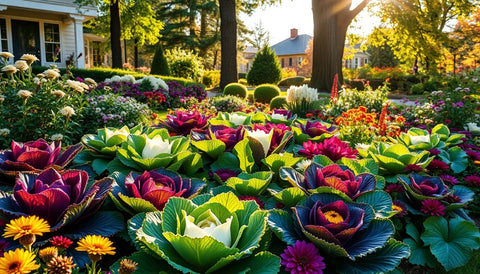Introduction
Fall-blooming irises are a hidden gem in the garden world. These vibrant flowers bring color and life to your landscape when many other plants have started to fade. Imagine stepping into your garden in the crisp fall air and being greeted by elegant blooms—doesn’t that sound enticing? In this post, we’ll dive deep into what fall-blooming irises are, their benefits, care tips, and how to design your garden to showcase their beauty. Buckle up for a floral journey!
1. Understanding Fall-Blooming Irises
A. What Are Fall-Blooming Irises?
Fall-blooming irises, specifically varieties like *Iris germanica* and *Iris ensata*, are perennial beauties known for their late-season blossoms. Unlike their spring-blooming relatives, these irises bring a splash of color as the nights grow longer and the air turns cooler.

B. Unique Features
One of the most captivating aspects of fall-blooming irises is their range of colors—from rich purples and blues to soft whites and yellows. Their flower shapes can vary dramatically too, adding a whimsical touch to your flower beds. Plus, their strappy green foliage offers a lovely contrast and a full season of interest.
2. Benefits of Incorporating Fall-Blooming Irises
A. Extended Blooming Season
One of the most compelling reasons to plant fall-blooming irises is the extended blooming season! While many plants begin to fade as summer closes, these irises stand tall, ensuring your garden remains vibrant long after others have bid farewell. They’re the perfect solution for late-season color.
B. Attracting Pollinators
Not only do iris blooms provide us with stunning visuals, but they also play a crucial role in attracting late-season pollinators. Bees and butterflies are often on the hunt for nectar during this time. By planting fall-blooming irises, you’re creating a haven for these essential creatures.
3. Selecting the Right Varieties
A. Popular Fall-Blooming Iris Varieties
When choosing fall-blooming irises, you have options! *Iris germanica* offers stunning tall bearded flowers, often in rich jewel tones, while *Iris ensata* (Japanese irises) provide wider petals and are often seen in mixed beds. Explore varieties like *Iris ‘Autumn Twilight’* or *Iris ‘Catherina’s Dream’* for a unique garden touch.
B. Considering Your Climate
Not all irises thrive in every climate. Check your hardiness zone before selecting your varieties. For instance, those in colder areas might opt for sturdier, more hardy varieties that can withstand the chill. Always choose plants suited to your specific environment for best results!

4. Planting Fall-Blooming Irises
A. Soil and Site Requirements
Want your irises to thrive? Start with the right soil! They prefer well-drained soil that’s slightly acidic to neutral, with a pH of about 6.0 to 7.0. Choose a sunny spot—they love basking in sunlight, making at least six hours of direct sunshine a must!
B. Planting Techniques
Ready to plant your irises? Here’s a quick guide: Dig a hole about a foot wide and deep. Space them roughly 18 to 24 inches apart to allow for growth. Gently position the rhizome with the top exposed. Cover lightly with soil, water them well, and you’re on your way to a blooming autumn!
5. Care and Maintenance
A. Watering and Fertilization
Irises like it a bit dry, so be careful not to overwater! A deep soak every week should suffice during the growing season. When it comes to fertilization, an application of a balanced fertilizer in the spring will get them off to a good start, but avoid high-nitrogen fertilizers as they can lead to weak plants.
B. Pruning and Deadheading
To keep your irises healthy and encourage future blooms, deadhead spent flowers right after they fade. Prune back spent foliage in late autumn to tidy up your garden—this helps prevent disease and ensures robust growth for next season!
C. Pest and Disease Management
While fall-blooming irises are generally hardy, they can face a few challenges from pests like aphids or diseases like root rot. Keep an eye out for any signs of trouble. Natural pest control methods like introducing ladybugs or using neem oil can help keep your irises thriving.

6. Designing Your Garden with Fall-Blooming Irises
A. Companion Planting
Irises pair beautifully with fall bloomers like asters, chrysanthemums, and even ornamental grasses. Think about creating harmonious color schemes that can add depth to your garden design. Imagine the contrast of vibrant irises against the golden hues of fall foliage!
B. Using Irises in Different Garden Styles
Whether you’re aiming for a traditional cottage garden or a sleek modern landscape, fall-blooming irises have a place in your design. They can serve as focal points, lend rhythm to borders, or highlight pathways—all while providing that striking late-season color.

7. Creating Seasonal Displays
A. Incorporating Fall Foliage and Other Blooms
Fall is a time for celebration, and your garden should reflect that! Pairing irises with late-blooming perennials and vibrant autumn foliage creates a stunning tapestry of color. Think about using ornamental cabbages or fall-blooming sedums to enhance the beauty of your irises.
B. Focal Points and Borders
Using fall-blooming irises as focal points can draw visitors in and create stunning pathways. Lining walkways or garden beds with these beautiful flowers can lead the eye toward other garden features, making your space feel more intentional and inviting.
Conclusion
Fall-blooming irises are more than just eye candy—they’re a fantastic way to extend your garden’s lifeline as summer wanes. By adding these beauties to your landscape, you’re not only injecting color and style but also creating a haven for pollinators. So, why not give them a go? Share your thoughts or iris gardening experiences in the comments below and let’s inspire each other!
Additional Resources
Looking for more help? Check out these helpful resources:





























Comments (0)
There are no comments for this article. Be the first one to leave a message!